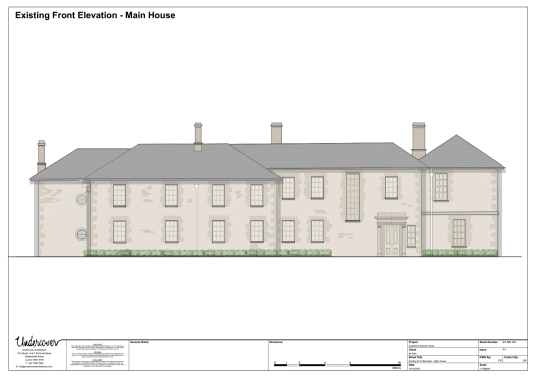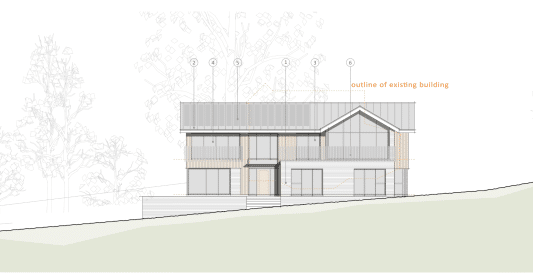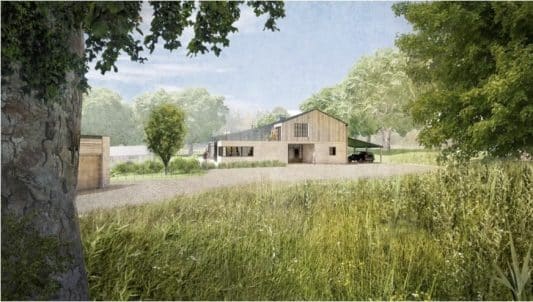

McLoughlin Planning with special thanks to Undercover Architecture, who worked with us on this project and provided the drawings, are pleased to have gained planning permission and listed building consent for the Grade II listed private house, Somerford Keynes House, in the Cotswolds.
Listed building features required for consent
The key areas that the owner wanted consent for were:
Contemporary Changes to the Main House
Alterations to the main house included in this recent granted permission were an addition of a French door with side lights to the side elevation, installation of rooflights in the roof valley between rafters (blocking up of a staircase to the basement with new staircase constructed to access cellar), and other minor workings such as the removal of modern partitions to allow for a more open plan space. In 2011, permission was granted for a stone porch to be added. This time round, a contemporary frameless glazed porch extension, complimented with a living green roof with pressed metal oversailing porch has been proposed to the side of the building to enhance a light and elegant feel to the house.
Family Orientated Outbuildings
In order for the outbuildings to have a more homely feel, internal changes were made to create larger spatial areas, including a raised ceiling, to accommodate for more bedrooms and a cosier setting at Kings Cottage. Proposed changes to the Coach House consist of a casement window to allow for an en-suit, which is located on the first floor to the linking section of the building. Originally, this wasn’t the case to be implemented, but due to concerns of excessive fenestration, the size of roof lights had to be changed and the dormer windows to be discarded. To allow for a modern way of travel and a tranquil Cotswold setting by the pool, an EV charging point and several air source heat pumps (ASHP), that are to be screened with timber for aesthetic purposes, were proposed.
Maintaining Historic Value and Consideration of Planning Policies
Overall, the proposed scheme has considered the historic value and beauty of the building’s original structure and the modern elements added to it over the years, therefore justifying that the new considered extensions and alterations granted for this permission will preserve the listed building for years to come. Additionally, careful considerations were sought out to ensure the development was aligned with legislation and policies, such as Section 16 of the NPPF (National Planning Policy Framework) for works to take place.
I’m a Listed Building Owner – When do I need to Acquire After Consent?
If you are a listed building owner and are wondering whether and/or when you need to acquire for listed building consent, please get in contact and one of our planning consultants will be able to assist. Additionally, please view our article here about when to acquire for listed building consent.
Joe Seymour – Associate Director
E: joe.seymour@mplanning.co.uk
T: 01242895008

McLoughlin Planning has successfully obtained planning permission to demolish an existing dwelling and construct a larger replacement dwelling in the Tewkesbury Borough. The site’s location within the Cotswolds National Landscape (formerly the Cotswolds Area of Outstanding Natural Beauty) and particularly the Gloucester-Cheltenham Green Belt presented significant challenges to achieving the client brief. In partnership with Coombes:Everitt Architects and Willder Ecology –we secured the demolition of a dilapidated dwelling dating from the 1920s, and the construction of a larger contemporary replacement dwelling.
Defining the term ‘materially larger’ in the Green Belt? A holistic comparison can be key
Councils often provide inconsistent guidance or, more challenging still, no guidance at all in terms of the size of a replacement building one is allowed to construct in the Green Belt. The key planning policy test for this application was that the new dwelling could not be “materially larger” than the existing dwelling, which inevitably raised the question: what is meant by this subjective term?
McLoughlin Planning successfully negotiated with the case officer to agree that the proposed dwelling was not materially larger, thus allowing planning permission to be granted. One of the key lessons learnt from this project is that it is not simply a question of comparing the existing and proposed floor areas. The Council will also take into consideration the differences in height, footprint, and volume, in addition to floor area, when deciding whether a replacement building is “materially larger”. Providing a holistic comparison can be the difference between approval and refusal.
I own a property in the Green Belt – how can I obtain planning permission for my project?
We are absolutely delighted with the positive outcome on this project, which will turn an almost unusable dwelling into a well-designed home. The team at McLoughlin Planning are very experienced in the nuances surrounding these types of development projects and navigating the complexities of challenging land designations. If you have a project that might benefit from our expertise, then get in contact with one of our planning consultants to find out how we can best assist you.
Joe Seymour – Associate Director
E: joe.seymour@mplanning.co.uk
T: 01242895008
Image source: Coombes: Everitt Architects (2024)
Project Team:
McLoughlin Planning (Planning consultants)
Coombes:Everitt architects (Architects)
Willder Ecology (Ecologist)

Planning permission secured for a barn conversion, providing a high quality and tranquil new family home near Hinchwick in the Cotswolds.
The barns form part of a small cluster of three barns situated in an isolated location in the open countryside and in the Cotswold AONB. Working closely with the architectural team and client, we evolved a scheme which would make best use of the two structurally sound barns, whilst re-using the land of one barn in a poor state of repair as a new residential garden and landscaping area.
Being in an isolated location normally results in conflict with planning policies, which seek to direct development to what are often considered more sustainable locations. However, as the project was seeking to make use of existing rural buildings, we were able to successfully argue that the project complied with paragraph 80 of the NPPF and a local planning policy which supports the reuse of modern rural buildings, permitted they are structurally sound and readily convertible. By providing a supporting structural report as part of the application, we were able to demonstrate this requirement.
In addition to structural issues, the development site’s location in the AONB and in a sensitive landscape area meant that the architectural design, landscaping, and layout of the proposed garden needed to be carefully considered to ensure the final buildings would not result in a significant visual increase of residential paraphernalia in the countryside. In addition to providing a detailed landscaping scheme, the architectures harmony with the buildings agricultural heritage meant the Council agreed that the project would not result in a visual harm to the wider countryside or AONB.
As is common with rural buildings, evidence was also needed that the barn did not provide valued habitat for protected species, such as bats. In this case it was demonstrated that the barns did not provide suitable habitat for bats and evidence was provided that the landscaping works proposed would provide significant biodiversity net gain and future habitat for local wildlife in accordance with National Government requirements.
This project demonstrates the importance of carefully considering what information could be requested and required to ensure the submission of a robust planning application. For barn conversions, the provision of structural surveys, ecological assessments, landscaping and carefully considered architectural design are just some of the requirements which commonly arise.
Nathan McLoughlin and Chris Fleming have successfully secured planning permission for many client’s barn conversion projects across the UK and are so pleased we could offer our experience to provide our client with a beautiful new home. It was also a great pleasure working with the team at Tyack Architects.
If you are considering your options for a barn conversion and would like to learn more about what is involved, then please give us a call on 01242 895008 or email chris.fleming@mplanning.co.uk
We have a simple objective: to get results for our clients by providing high quality planning consultancy. That means our goal is to secure planning permission or an allocation for development.
We have used McLoughlin Planning (London) on two or three occasions and found them efficient, knowledgeable and excellent at negotiating with Local Authorities and third parties. Their concise and specific advice helped us win approval for schemes which had previously been notified for refusal. We would not hesitate using them again for planning issues in London.
Rob Haine Haine & Co. Ltd.Having worked with Nathan and his team for a number of years, I have found he offers a rare combination of intellectual rigour and practical focus, coupled with a commercial approach. He is solution orientated and capable of delivering on accelerated timelines for clients at the highest level with exacting standards and positive results.
Craig Jordan Jordan HennessyI have known Nathan for over 10 years and have used his services to great effect where professionalism, tenacity and a clear focus have been required, to deliver successful results. With a cool head, aligned with attention to detail and commercial acumen, he and his team work effectively and diligently and we look forward to engaging on other projects in the future
Grant Westall-Reece AvantWorking with McLoughlin Planning has been very enjoyable. I have always found the team knowledgeable and easy to work with. They have always been professional and have managed to achieve the results desired.
Matt Richardson Legal and General HomesWe have used Nathan and his team to help with a range of planning matters on a number of occasions. I have always found them to be extremely helpful, responsive and proactive. Nathan always makes himself available for phone calls and or meetings. He is especially patient and good at explaining complex matters in a very user friendly way.
Mark Lawson The Buying SolutionWe have worked with McLoughlin Planning for many years and have always been very pleased with level of service in helping us navigate the ever-changing planning system. I also never cease to be impressed by the answers to the completely random questions I ask Nathan about possible new sites, normally in several different locations at one go.
Ian Hitchings Partridge Homes (Cotswolds) LtdAfter many years of working with Nathan and his team, we know we can trust their planning opinion. They often provide a solution that demonstrates Planning experience and expertise and the benefit of their input is measured by the planning approval success and infrequent need to go to appeal on a decision.
George Paton WebbPatonWe have consistently used McLoughlin Planning to successfully promote greenfield development sites in a variety of locations. Aside from their technical capabilities, we also value their considered approach to projects - particularly when dealing with delicate and complex planning issues. This makes them a natural part of our team.
Alistair Watson Welbeck Strategic LandIf you are interested in finding out how we can help you please get in touch
Notifications